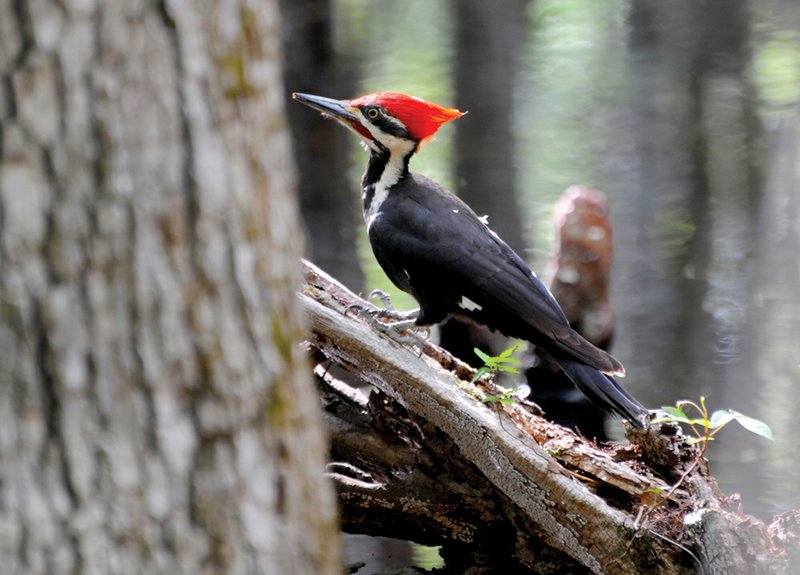Throughout the day, I have been watching the antics of several woodpeckers going about their activities in my backyard just outside Little Rock.
A downy woodpecker, one of the smallest, tamest and most abundant of the species that live in Arkansas, has been visiting a feeder laden with suet cakes. He is beautifully patterned with black and white, with a broad white stripe down his back. I know this one is a male because he has a small red patch on the nape, a bit of color missing on the otherwise look-alike females.
Occasionally, a hairy woodpecker comes to the feeder, too. It could easily be confused with the downy, which has almost identical plumage. But the hairy is slightly larger and has a longer bill and unmarked white outer tail feathers. Downies have black spots or bars in the white of the outer tail feathers. The past week or so, this one has been drumming loudly on a tree limb in the forest above our house, part of its courtship ritual. When the bird attracts a mate, they will use their sharp beaks to excavate a nesting cavity in a living tree, a behavior unlike that of most woodpeckers, which use dead trees.
A pair of red-bellied woodpeckers frequent our yard as well. They, too, enjoy the treats we place for them, especially suet and sunflower seeds. But even when they come down and give us up-close views, it’s hard to see the reddish tinge on the belly from which the species gets its common name. “Zebra-back” or “ladder-back” would seem a more appropriate moniker, considering their black-and-white patterns. The handsome male sports a crimson-red crown and nape. On the female, only the nape and forehead are red.
A few weeks ago, we often saw yellow-bellied sapsuckers in our woodlands, too. Their name comes from their habit of boring lines of shallow holes in tree bark from which they feed on sap and insects attracted to the sap holes. Unlike our other woodpeckers, which stay year-round and nest here, these little beauties are migratory. They’ve left now for northern breeding grounds and won’t return until fall.
In a city park just down the road, I often see northern flickers. They are larger than the woodpeckers already mentioned, and unlike their cousins, which usually forage for insects and other goodies in trees, northern flickers spend much of their time on the ground feeding on ants. They are barred black and brown above and have a white rump patch. The underparts are buff with black spotting, and each has a broad black “bib” across the upper breast. When the birds fly, their vivid yellow underwings flash like caution lights.
Red-headed woodpeckers live in the park, too. The adult males and females are easily recognized by their all-red head, black-and-white body and white wing patches. Immature birds have a dull brown head. This species seldom drills trees for insects, preferring instead to dart out into the air to catch flying insects. Redheads also love nuts, especially acorns, and I often see a pair at the park caching acorns in an old bluebird house for later use.
We’ve never seen a red-cockaded woodpecker in our neighborhood — no big surprise, because this bird is an endangered species restricted to tracts of mature pines in other areas of the state. So far no ivorybills, either. But we are, on occasion, treated to the loud raucous calls, resonant drumming and majestic sight of pileated woodpeckers. Despite the fact that they are as big as crows, these woodpeckers are adept at keeping out of sight. Obtaining a close view of one usually requires careful stalking. Both sexes have a red crest and, when perched, show a solid-black back. The large bill is black, and males have a scarlet “mustache” extending from the base of the bill back to the neck. In females, the mustache is black.
If you would like to learn more about woodpeckers from personal observation, there are several things you can do to encourage these birds’ presence on your property. For example, completely or partially dead trees provide feeding, roosting and nesting sites for woodpeckers, so when practical and safe, leave some snags that previously have been damaged by insects, disease, fire or storm. This also will benefit other cavity users such as chickadees, titmice and flying squirrels.
Nesting boxes are used by several species of woodpeckers. Construct the boxes from rough wood or hollowed-out logs using plans you can find on the Internet or in books. Flickers prefer nesting boxes completely filled with wood chips or coarse sawdust that they “excavate” to suit themselves. For other species, cover the box floor with a 2-inch layer of wood chips or sawdust. Place woodpecker boxes along woodland edges, 12 to 20 feet up on tree trunks exposed to direct sunlight. Check them frequently, and remove nests constructed by starlings and other undesirables.
Though insects comprise a large part of the woodpecker’s diet, most species also feed on fruits, nuts and berries. The backyard wildlife manager can attract woodpeckers with plantings of dogwood, elderberry, sumac, pokeberry, corn, beech and oak trees, hazelnuts, blackberry, wild grapes, Virginia creeper, mulberry, huckleberry and other plants. Woodpeckers also visit backyard feeders where suet, peanut butter, cracked nuts and sunflower seeds are provided.
Woodpeckers aren’t strikingly colorful birds like the cardinal and bluebird. They don’t sing beautiful songs like the mockingbird and the thrush. They don’t astound us with their annual migration odysseys like ducks and hummingbirds, nor do they evoke the feeling of raw excitement kindled by the sight of a majestic eagle soaring over a river or the sound of a wild turkey gobbling in the woods. They provide no trophy for the hunter’s den, no repast for the holiday table. Yet it is also true that woodpeckers possess a special charm, and they exert a strong appeal on anyone who enjoys watching wildlife. Seeing them brings special joy into our lives.
